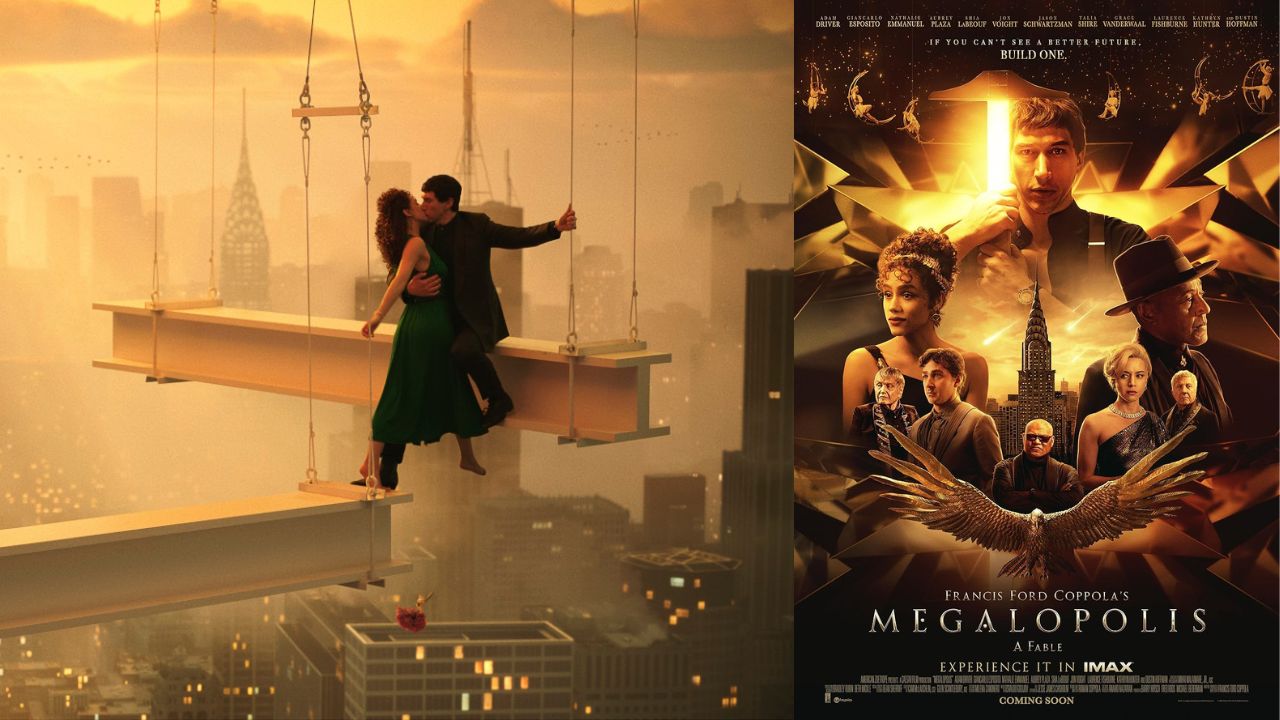Francis Ford Coppola, the legendary filmmaker behind The Godfather and Apocalypse Now, returns to the cinematic arena with Megalopolis (2024), a project that has been in development for over four decades. A grandiose fusion of futuristic fantasy, philosophical musings, and visual extravagance, Megalopolis is a film that promises much but delivers with an erratic, at times bewildering, sense of scale and ambition. This review will dive deep into its plot, character development, visual storytelling, thematic complexity, and Coppola’s directorial choices, ultimately assessing whether this film is a masterpiece or a misstep.
Plot Analysis: An Epic Journey of Utopian Dreams and Dystopian Realities
The narrative of Megalopolis revolves around Cesar Catilina (Adam Driver), an architect who envisions a utopian metropolis called Megalopolis, built on the ruins of New Rome, a futuristic version of New York City. Cesar’s vision promises to revolutionize society through a sustainable, shape-shifting material that could change the very structure of urban life. However, his ambition faces opposition from the city’s mayor, Franklyn Cicero (Giancarlo Esposito), a political powerhouse skeptical of Cesar’s grand plans.
Cesar’s journey is not merely architectural; it’s a quest for power, legacy, and love. His romantic entanglement with Julia Cicero (Nathalie Emmanuel), the mayor’s daughter, adds complexity to his mission. While their love affair unfolds against the backdrop of societal upheaval, Cesar’s relationships with other key players, such as his cousin Clodio (Shia LaBeouf) and his enigmatic lover, Wow Platinum (Aubrey Plaza), further entangle the narrative with personal betrayals and political intrigue.
Coppola’s screenplay, however, can feel disjointed. The film is rich with literary and philosophical references—ranging from Roman history to Shakespeare—but often sacrifices coherence for grandeur. The plot meanders, with characters making sudden decisions, and several narrative threads are left unresolved or abandoned. This lack of focus weakens the film’s overall impact, leaving audiences to piece together meaning from a visually stunning, yet narratively chaotic, spectacle.
Character Development: Visionaries, Skeptics, and Archetypes
Cesar Catilina is the driving force of Megalopolis, embodying the archetype of a visionary whose dreams are too radical for a pragmatic world. Adam Driver delivers a powerful performance, capturing Cesar’s inner turmoil and existential burden. Yet, the character often feels more like a symbol than a fully realized individual—an embodiment of ambition rather than a person with relatable human emotions.
On the opposite end is Franklyn Cicero, played with sharp skepticism by Giancarlo Esposito. Cicero is the perfect foil to Cesar, a practical leader wary of grandiose ideals. His character, while more grounded, is somewhat underdeveloped, primarily serving as an antagonist to Cesar’s utopian vision.
Julia Cicero, the love interest, offers little beyond her role as a romantic foil. Despite her initial portrayal as a rebellious party girl, her character arc never fully takes off, leaving her romance with Cesar feeling forced rather than inevitable. Aubrey Plaza’s Wow Platinum provides much-needed comic relief with her femme fatale persona, though even her character feels disconnected from the central narrative at times.
Visual and Cinematographic Brilliance
Visually, Megalopolis is nothing short of spectacular. Coppola’s collaboration with cinematographer Mihai Mălaimare Jr. results in an unforgettable visual experience. The film’s blend of ancient Roman aesthetics with futuristic architecture creates a unique and mesmerizing world. Scenes of towering statues crumbling in despair, grandiose cityscapes, and surreal dream sequences evoke a sense of wonder that transcends the film’s narrative shortcomings.
The use of IMAX technology and innovative camera techniques also enhances the film’s immersive quality. The visual symbolism—such as the collapsing statues representing the fall of civilizations—adds depth to the story, even when the dialogue and character development fall short. However, some sequences, particularly a Colosseum-inspired wedding, drag on too long, weakening the film’s overall pacing.
Themes and Messages: A Meditation on Power and Ambition
Megalopolis tackles themes of ambition, societal structures, and the cyclical nature of civilizations. The parallel between modern America and ancient Rome is central to the narrative, with Coppola drawing clear connections between the greed and hubris of today’s political and financial elite and the downfall of past empires. Cesar’s utopian dream is not just about building a city but about challenging the established order—a vision that is both inspiring and dangerous.
Yet, the film’s thematic exploration feels muddled. While it raises important questions about progress, ambition, and the role of visionaries in shaping society, it often becomes bogged down by its own complexity. The philosophical underpinnings, while thought-provoking, can feel overwhelming and disconnected from the emotional core of the story.
Comparisons to Other Films
In its thematic ambition and visual style, Megalopolis invites comparisons to other films that blend dystopian futures with utopian ideals, such as Fritz Lang’s Metropolis (1927) and Ridley Scott’s Blade Runner (1982). However, where those films succeed in balancing visual spectacle with coherent storytelling, Megalopolis often falters. Like Apocalypse Now (1979), one of Coppola’s earlier masterpieces, Megalopolis aims to be an epic meditation on human nature, but it lacks the narrative precision that made Apocalypse Now such a landmark in cinema.
Direction and Final Thoughts
Francis Ford Coppola’s direction is undeniably bold, and Megalopolis feels like a deeply personal project. The film’s ambition is commendable, as it attempts to push the boundaries of conventional filmmaking. Coppola’s decision to finance much of the film himself adds a layer of intrigue, suggesting that this is less about commercial success and more about artistic expression.
However, Coppola’s improvisational approach to the film’s narrative structure leaves Megalopolis feeling unfinished. While the visuals are breathtaking, the characters and story fail to resonate on an emotional level, making it difficult to fully engage with the film’s lofty ideas.
Final Verdict: A Beautiful Mess or a Masterpiece?
Megalopolis is an ambitious film that will undoubtedly divide audiences. Some will marvel at its visual grandeur and philosophical depth, while others will find its narrative incoherent and its characters underdeveloped. Ultimately, this film is less about its plot and more about the experience of watching a cinematic vision come to life. For those willing to embrace its chaos, Megalopolis offers a fascinating, if flawed, journey.
Is it worth watching? If you are a fan of Francis Ford Coppola’s experimental works, or you appreciate visually stunning, thought-provoking films, Megalopolis is worth your time. However, those looking for a coherent story and relatable characters may find themselves frustrated.
Curious about Coppola’s epic vision? Watch the official trailer here. And if you’re ready to dive into the world of Megalopolis, check out where you can stream it here. Looking for more high-rated films? Visit this list for the best recommendations.





